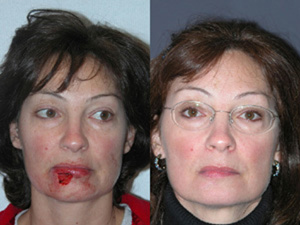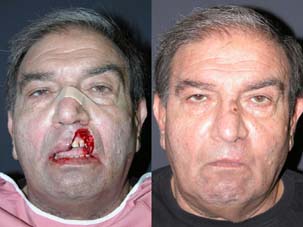New York Center for Facial Plastic Surgery
Schedule a consultation
Schedule today
View Before and After MOHs Surgery Patient Photos by Top Facial Plastic Surgeon, Dr. Andrew Jacono.
Nasal Defect Reconstruction with Multiple Staged Repair. This defect required a two staged surgery using a pedicled (stays attached to the donor site) paramedian forehead flap. The second stage involved sectioning the flap attachment


Upper Lip Defect Reconstruction. A nasal crescenteric lip advancement flap was utilized to reconstruct this defect of the lip.

Cheek Defect Reconstruction. This patient had a cheek rotation flap for reconstruction in a single stage.

Eyelid Defect Reconstruction. A specialized flap called a tenzel flap was used to reconstruct the eyelid, and the lacrimal (tear duct) apparatus was reconstructed. A Tenzel flap borrows from the cheek skin.

Lower Lip Defect Reconstruction. A vermillion lip advancement flap was utilized to reconstruct this defect of the lip.

Nasal Defect Reconstruction with Multiple Staged Repair. This defect required a two staged surgery using a pedicled (stays attached to the donor site) paramedian forehead flap. The second stage involved sectioning the flap attachment.

Forehead Defect Reconstruction. Patient underwent an O to T advancement flap, borrowing along the hairline.

Full Thickness Upper Lip Defect Reconstruction. A nasal cresenteric lip advancement flap was utilized to reconstruct this full thickness defect of the lip.

Eyelid Defect Reconstruction. A specialized flap called a tenzel flap was used to reconstruct the eyelid, and the lacrimal (tear duct) apparatus was reconstructed. A Tenzel flap borrows from the cheek skin.

Cheek and Eyelid Defect Reconstruction. Patient underwent a neck transposition flap, and forehead and cheek rotation flap to close this large defect.

Nasal Defect Reconstruction. A Glabellar Flap was used to close this nasal defect and prevent alar distortion.

Nasal Alar Defect Reconstruction. This defect required a two staged surgery using a pedicled (stays attached to the donor site) cheek flap and ear cartilage graft to reconstruct the natural curvature of the nasal rim. The second stage involved sectioning the flap attachment.

Eyelid Defect Reconstruction. A specialized flap called a tenzel flap was used to reconstruct the eyelid, and the lacrimal (tear duct) apparatus was reconstructed. A Tenzel flap borrows from the cheek skin. A full thickness skin graft was also required.

Full Thickness Upper Lip Defect Reconstruction. A nasal cresenteric lip advancement flap was utilized to reconstruct this full thickness defect of the lip.

Nasal Defect Reconstruction with Multiple Staged Repair. This defect required a two staged surgery using a pedicled (stays attached to the donor site) paramedian forehead flap. The second stage involved sectioning the flap attachment.

Ear Defect Reconstruction. A chondrocutaneous V to Y advancement flap with a full thickness skin graft was used to restore natural contour to this ear.

Eyelid Defect Reconstruction. A glabellar (forehead) transposition flap was used to close this eyelid defect.

Nasal Tip Defect Reconstruction. A bilobed flap was used to close this nasal defect and prevent alar distortion.

Nasal Defect Reconstruction. A single staged meloabial (cheek skin) transposition flap was used for reconstruction.


Accessibility: If you are vision-impaired or have some other impairment covered by the Americans with Disabilities Act or a similar law, and you wish to discuss potential accommodations related to using this website, please contact our Accessibility Manager at (212) 570-2500 .